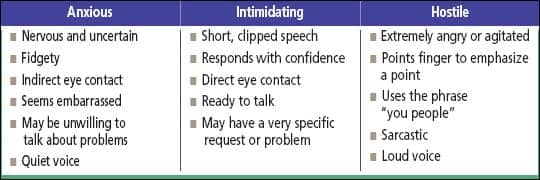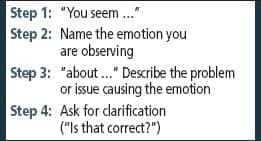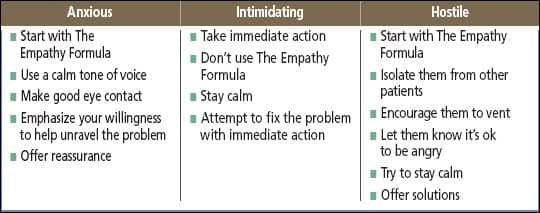Through our experiences in the hearing care industry, we have identified three fundamental skills that make the trained office professional an essential part of your work staff:
- Converting phone calls into appointments;
- Greeting patients and putting them at ease;
- Managing the opening moments of a problem case.
As a manager or owner, if you can provide clear direction on improving these three skills, the productivity of your office will improve.

|

|
| Brian Taylor, AuD, is the global training manager and Kimberly Black is an offices systems training specialist for Amplifon, Plymouth, Minn. | |
Conventional wisdom suggests that a successful hearing aid dispensing practice revolves around the skill level of the hearing care professional. Some combination of technical expertise and relationship-building skills is required on the part of the hearing care professional if the office wants to be successful.
While the hearing care professional needs these skills to be successful, perhaps the industry is overlooking the pivotal nature of the unheralded trained office professional (TOP) who works in the front office. As we will demonstrate in this article, taking the time to better hire and train the TOP staff results in a more productive practice with higher levels of satisfied patients.
For example, let’s say that you are running a week-long promotion in your local newspaper. You are managing two offices that have an average selling price of $2,000 per unit, a close rate of 40%, and a bilateral fitting rate of 80%. In Office 1, the front office professional is poorly trained, while in Office 2, you have taken the time to hire the right person and invest the necessary time to train this person on the essential job duties. In this example, let’s also say that you received on average 12 calls per day over a 1-week period in each office inquiring about the promotion. Table 1 shows the difference between the revenue generated when all the operational variables stayed the same between the two offices.

|
| Table 1. A hypothetical comparison of results for two hearing aid dispensing offices with the same operational variables. The key difference between these two offices is the quality of the front office professional. |
The purpose of this article is to review the essential duties of an effective front office professional, and how they contribute to the overall success of a hearing aid dispensing practice. There are many skills contributing to overall success as a trained office professional, including computer skills and some basic knowledge of the psychological aspects of hearing loss. However, through our experiences in the hearing care industry, we have identified three fundamental skills that make the front office professional an essential part of your sales force. As a manager or owner, if you can provide clear direction on improving these three skills, the productivity of your office will improve.
1) Converting Phone Calls into Appointments
The primary responsibility of the TOP is to schedule appointments. As the example in Table 1 demonstrates, the TOP is an integral part of your practice’s sales and marketing force. Given this fact, it makes sense to take the time to select the right person for the job, and provide them the training and tools they need to be successful.
Our experience suggests that the typical TOP haphazardly fields phone calls for two reasons:
- The TOP fails to understand their primary role within the organization as a first point of contact during the consultation and buying cycle.
- They lack the proper training to get the job done. Below are some tools that provide a clear path from start to finish on scheduling appointments over the phone.
Rely on an opening script. Research suggests that 55% of communication is conveyed with vocal inflection, 38% via body language, while just 7% is conveyed with words. Of course, when communicating over the phone, you cannot rely on body language to convey your message; therefore, both vocal inflection and words take on greater importance. During a phone conversation, research suggests that about 70% of the message is conveyed with vocal inflection and up to 30% is verbal. A confident and professional tone can mean the difference between success and failure. Therefore, following a script can be an effective tool when it comes to getting your message across with prospects calling your practice to inquire about your latest promotion.
Below is an example of a script that can be used to greet the patient. Scripts are valuable tools for helping TOPs convert phone calls into appointments. As office manager, it is up to you to determine the exact wording of your call conversion script.
- Thank you for calling (insert company name). This is (insert your name). How may I help you?
- May I ask your name? (verify spelling of name)
- Mr/Mrs/Ms _____, the first step is to find out a little background history about you and so may I ask you a few questions?
- Are you calling for yourself or someone else?
- Have you (they) had a hearing test before?
- In order for us to have the most effective test results, it’s important to use a familiar voice during the test. It is necessary to bring a family member to the appointment for this purpose. Who will be coming with you?
- We are located at (insert store address). Do you need me to send you a map or directions to our location?
- I’ll be confirming this appointment the day before (insert date). What number would be a good number to reach you?
- (Insert customer name) thank you so much for calling and we look forward to seeing you on (insert appointment date and time). We are really happy you made the right choice in contacting (insert company name). I’m certain we’ll take great care of you! Do you have any other questions I can answer for you?
Answer the phone with a pleasant-sounding voice. Since vocal inflection is such a significant part of communication over the phone, the proper vocal intonation is even more important than a script. One of the universal rules of communication is that your initial greeting sets the tone for the entire conversation. Listeners tend to mirror the emotions of the speaker. For example, if you are agitated when you make a call to a customer service desk, and the receptionist answers the phone with a pleasant demeanor, it is extremely difficult to stay agitated throughout the entire conversation.
It’s important to think about how this relates to the hearing-impaired customer. Many hearing-impaired customers and the family members making the call to your office are embarrassed about the condition and have been denying the problem for several years. When you are friendly and engage the customer with a pleasant-sounding voice, you are much more likely to start off on the right track.
Additionally, there is research suggesting that your body language affects your vocal tone. When you sit upright and smile, you will create a positive emotional state and you will be much more likely to answer the phone with a pleasant-sounding voice.
Think about how a great baseball hitter approaches each at bat. Most major league batters have a methodical routine they go through before every pitch. There is no reason you cannot have that same approach to answering the phone. When the phone rings, take a deep breath, sit up straight and look straight ahead, and clear your mind of all other activities. (Many times when we answer the phone, we might be in the middle of another intense situation, and we unknowingly carry this intensity into the phone call.) The bottom line is that a ritual is needed before answering the phone in order to create an aura of pleasantness.
Be brief. There is no better way to lose a call than to give too much information. Excessively long and meandering answers confuse your customer, and often sound contrived and insincere. Your responses should be brief and to the point. When in doubt, simply say that the hearing care professional in your clinic would love to provide a more detailed explanation, and that this requires the patient to make a personal visit to the clinic.
Track companion attendance. Effective managers know that, if they want to improve something, they must first begin to measure it. Considering the fact that the majority of our customers will not make a purchasing decision without input from their spouse or significant other, it is critical to the success of the business to monitor the number of customers arriving at the first appointment with a companion. Front office professionals must be trained on how to encourage prospects to bring their companion to the initial consultation appointment. As a general rule, 60% to 70% of all first-time consultation appointments should bring a companion.
2) Greeting Patients and Putting Them at Ease
In any high-margin, low-volume business (eg, hearing care), little things can make a big difference in your ability to serve customers. Anything, from the inflection in your voice when you personally greet the customer, to how you answer questions, contributes to your success.

|
| Figure 1. Although SOLERS isn’t a word, it is a helpful way to remember the essential ingredients to greeting patients in your office. |
Taking the time to fine tune the details of your initial greeting of customers when they arrive in your office is likely to improve business results. Figure 1 outlines the essential behaviors you should display during the initial greeting in order to make the customer feel welcome in your office and put them as ease. Through practice and repetition, you can improve these core greeting and communication skills. By meticulously performing each of the behaviors listed in Figure 1, you are more likely to put the customer at ease.
3) Managing the Opening Moments of a Problem Case
Every front office professional has the unfortunate opportunity of having to deal with challenging and sometimes difficult or confrontational patients. In these situations, emotions can easily overtake the content of the conversation, and things can suddenly spiral out of control.
An important part of the TOP’s job is to help manage these stressful and sometimes awkward situations When a patient with a problem calls your office or shows up without an appointment to see the hearing care professional, it is important to first recognize which of the three “problem” conditions they might fall into.
An unhappy customer might arrive at your office in one of three states or conditions: 1) Anxious; 2) Intimidating, or 3) Angry. The TOP’s ability to first recognize the state the patient is in, and then address the condition with the proper communication skills, will help the conversation get off on the right track.

|
| Table 2. The typical behaviors you can expect from the three conditions of customers presenting with a problem. |
Table 2 outlines several typical behaviors related to each of the three conditions.1 Although not every patient falls into one of these three categories, the majority of hearing-impaired patients will present to your office at one time or another in one of these three states or conditions listed in Table 2. Of the three conditions, most hearing-impaired patients will fall into the anxious category, while very few (fortunately) make it into the “Hostile” category.
It is not enough for the TOP to recognize the condition of the customer. Once the condition has been recognized, the TOP must utilize an effective communicate strategy in order to find a solution to the problem. One tool that can be used with virtually all customers is called “The Empathy Formula.”2 The Empathy Formula is a well-known tool from the field of psychology that gives us the means of keeping the conversation on the right track. There are four steps to The Empathy Formula shown in Table 3.

|
| Table 3. The Empathy Formula. |
The Empathy Formula works well for two of the three conditions described in Table 2. For the “Anxious” and “Irate” conditions, the formula is a useful tool for allowing the patient to feel that they have been heard. For example, for a customer arriving at your office with trouble getting the hearing aids into the ears, The Empathy Formula is a useful way to offer reassurance and support, while also allowing the patient a chance to elaborate on the situation causing anxiety and confusion.
On the other hand, The Empathy Formula is not an effective tool for customers presenting in the “Intimidating” condition. For these customers, immediate actions—not words—are required. For example, let’s say you have a customer who has visited your office two or three times over the past few months for a minor hearing aid adjustment. The patient, who is getting frustrated, is calling to be seen for a specific hearing aid adjustment, and the TOP tells the patient that it is going to be more than a week before you can fit them into the provider’s busy schedule. In this case, using The Empathy Formula might result in upsetting the patient further, turning an “Intimidating” customer into an “Irate” one.

|
| Table 4. Suggested approach for handling each of the three conditions. |
Once the TOP has successfully booked an appointment, their ability to greet patients, recognize the condition of the customer, and align their communication style to fit the customer’s condition cannot be overemphasized. Aside from booking an appointment and ensuring that a companion accompany the prospective customer on the first appointment,3 it is difficult to precisely measure the true financial impact of an effective front office professional. Given the fact that an outstanding TOP must reassure a reluctant first-time buyer, calm a nervous patient, or coolly work a frustrated new hearing aid user into a busy schedule, she is an essential part of your sales and marketing team.
Even though they are primarily utilized in the front office for initiating customer contact, the TOP’s ability to offer reassurance and support throughout the customer’s journey cannot be overemphasized. Considering the strong stigma of hearing aid use, coupled with many of the associated behaviors of untreated sensorineural hearing loss in a predominantly elderly clientele, the job of the TOP is extremely challenging.
Through the proper execution of effective communication skills, including The Empathy Formula, front office professionals will become an indispensable part of your sales force by improving three specific skills sets, as detailed in this article.
References
- Flynn B. Featured presentation: British Society of Hearing Aid Audiologists; April 18, 2008; Birmingham, UK.
- Egan G. Exercises in Helping Skills. 8th ed. Pacific Grove, Calif: Pacific Grove Books; 2007.
- Hansen V. Ring! “How much are your hearing aids?” Hearing Review. 2005;12(13):34-35, 78.
Correspondence can be addressed to Brian Taylor at




